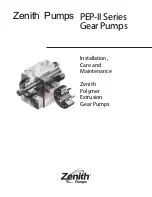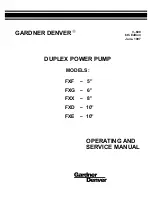
2
WARNING! THE PUMP MUST BE PLACED WHERE
INTERFERENCE BETWEEN THE VEHICLE’S BODY AND ITS CHASSIS
MOVEMENT IS AVOIDED. THE PUMP AND ITS CONNECTING HOSES MUST NOT BE SUBJECTED TO LOW
GROUND CLEARANCE, WHERE ANY FLYING ROCKS OR ROAD DEBRIS CAN CAUSE DAMAGE. FAILURE TO
AVOID THESE HAZARDS WILL LEAD TO PUMP DAMAGE, WHICH COULD RESULT IN FIRE AND/OR PROPERTY
DAMAGE, SERIOUS INJURY, AND/OR DEATH.
1. Select a mounting site as close as possible to the fuel tank and away from possible sources of heat as detailed previously. Mount
the controller close to the pump taking the harness length into consideration while choosing a mounting location.
2. Templates of the pump and controller mounting holes are included at the end of this manual. Use the included paper template and
drill (4) 1/4 holes for the pump and #8-32 for the controller.
3. Mount the pump (outlet pointing forward) using (4) 1/4 bolts (not included). Mount the controller using #8-32 bolts (not included).
NOTE:
To ensure pump life and flow efficiency, a 100 micron pre-filter must be installed between the tank and the pump inlet. The
filter should be supported in such a manner that it does not hang from the fuel lines. Pre and Post filters can be mounted
directly to the pump if space allows.
4. Install the recommended AN fuel fittings. (Refer to the chart on page 1 for minimum recommended fuel fitting and hose size)
WARNING!
This pump is not designed to use a standard conical seat style union in the inlet or outlet of the pump. Example:
Part # AT981510ERL (Figure 1). Use of this style fitting will restrict flow and WILL lead to poor performance and
potential pump failure. The ONLY correct fitting to use for the 12-3000-2 is TWO of the contoured port fitting with
an O-ring seal such as Part # AT985010ERL (Figure 2). The ONLY correct fitting to use for the 12-3000 is a
contoured port fitting with an O-ring seal such as Part # AT985016ERL (Figure 2).
Figure 1
Figure 2
5. Connect the fuel supply line from the tank to the pre-filter and then
to the inlet port of the pump
. Connect the main fuel feed line
to the outlet port of the pump, then to the post filter. See
Figures 4a and 4b.
If using a pump with dual inlets, both inlets MUST be
plumbed or pump failure will occur! See
Figure 4c.
NOTE:
Avoid unnecessary restrictions, such as sharp bends and undersized fuel fittings and hoses. Avoid routing fuel lines in areas
that would cause chafing. All fuel line connections must be leak proof.
WARNING! IF SPLICING INTO EXISTING FUEL LINES, USE EXTREME CARE TO AVOID CONTAMINATING THE LINE WITH
RUBBER OR METAL SHAVINGS, AS THIS WILL DAMAGE THE PUMP. IF THE FUEL LINE HAS BEEN CUT, IT IS
ESSENTIAL THAT IT BE CLEANED TO ENSURE THAT NO METAL OR RUBBER PARTICLES ENTER THE FUEL
SYSTEM. THIS IS PERFORMED BY BLOWING THE LINE CLEAN WITH COMPRESSED AIR. HOLLEY DOES NOT
RECOMMEND THE PROCEDURE WHERE THE COIL WIRE IS DISCONNECTED, THE ENGINE IS CRANKED, AND
THE FUEL IS COLLECTED IN A CONTAINER. SPARKING CAN OCCUR DURING THIS PROCEDURE, WHICH MAY
RESULT IN A FIRE AND/OR EXPLOSION.
WARNING! DO NOT OVER TIGHTEN THE FITTINGS ON THE FUEL PUMP. TORQUE the fittings in the pump as follows.
(-16AN to 700-840 in. /lbs., -10AN to 360-430 in. /lbs., -8AN to 270-300 in. /lbs. and -6AN to 150-170 in. /lbs.)
USING A FUEL PRESSURE REGULATOR WITH THE VR2 FUEL PUMP:
NOTE:
A return style fuel pressure regulator is required for use with the Holley VR2 fuel pumps. Please refer to the chart on page one
for recommended fuel pressure regulators. Refer to figures 1a and 1b for recommended plumbing scenarios.
NOTE:
Refer to the installation instruction included with the fuel pressure regulator for steps on mounting and adjustments.
NOTE: Depending on your application, choose one of the following examples:
Summary of Contents for 12-3000
Page 10: ...10 Fuel Pump Template...
Page 11: ...11 Controller Template...






























